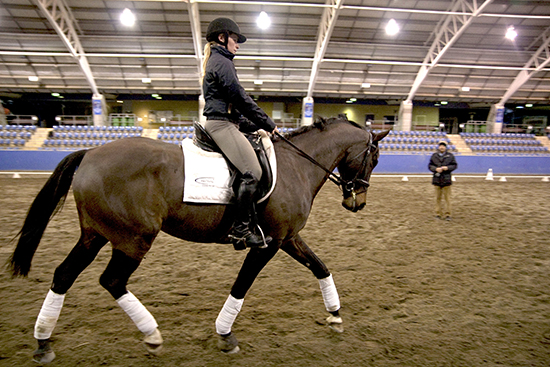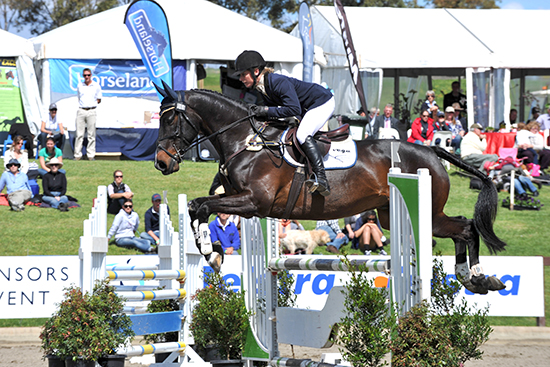
Story by Emma Mason and Photos by Rachel Smith Furdography
Whilst I had certainly heard of Christoph Hess (he is to dressage what Sean Connery is to films), my first ‘encounter’ with Christoph and his methods was at the recent Melbourne Three Day Event. Christoph headed the ground jury, and also held a “masterclass” for the spectators the evening before the dressage phase. Interested to hear what Christoph had to say, and admittedly, keen to suss out what he would be looking for in the following day’s dressage phase, I joined the enthusiastic crowd in the indoor at Werribee. I was enthralled: The man is so knowledgeable, so experienced, yet his way of teaching is so relaxed and simple. And he’s a genuinely nice person with a great sense of humour. So when the NSW Institute of Sport generously offered 2 spots for “eventing riders” in Christoph’s clinic the following weekend, I jumped at the chance.
With Pharinelli having a well-earned rest after his efforts at Melbourne, it was Harley’s turn to step up. Having spent the past week chilling out in the paddock, there were only a few days to get Harley (a.k.a Poker Face) back into ‘work’ mode. As was to be expected, Harley was feeling fresh, and there were some rather large bucks (of the Harley’s-tail-hitting-Emma’s-ponytail variety) in the sessions leading up to the clinic. Thankfully, upon arriving at the Sydney International Equestrian Centre, Harley sensed the occasion and solemnly entered the arena, halo shining bright.
We begin at the walk, and Christoph breaks the ice by asking questions about Pharinelli, me, my other horses, and my goals. After we’ve chatted for a bit, Christoph says; “this horse has a good walk. Let me see some trot and canter, and then we’ll make a plan”.
I trot on. After a few circles, Christoph indicates for us to use the whole arena. Harley is quite spooky and not too keen on going into the corners (there’s a scary table with video camera up one end, equally spooky gate at the other). We wait for him to relax a little, then begin schooling those corners. Christoph is looking for Harley to accept my inside leg: “Circle 10 metres at K… Go INTO the corner, he must go deep into the corner.
You must control the hindquarters with your outside leg, the hindquarters are not to swing out. The horse must learn to trot on the circle line, hind feet stepping where the front feet were. Your horse at Melbourne had a little problem with this, his quarters came out and he hit the arena wall…” Christoph has a good memory – in my first turn off the centreline at Melbourne, Pharinelli swung his quarters out and his hind foot struck the edge of the arena with a resounding bang, scaring himself, me, and it would appear, the judges.
When Christoph is happy with the circle, we continue on through the short side of the arena and circle again in the corner. “Not so much inside rein; the horse has to perform the circle on the outside rein and leg aids, which will also help control the quarters. Give and take with the inside rein – this will encourage the horse to be in self-carriage, and not lean on the rein. Ah, good. Now ride shoulder in up the long side (just as well, I’m starting to feel pretty dizzy) and 10 metre circle again at the end of the long side.“
We repeat the exercise a number of times, both left and right, concentrating on being able to ‘give and take’ the reins, and keeping Harley active and in front of the leg all the while. “Ah, this is good: The horse has started to loosen, become more elastic, yes?” Indeed, Harley is starting to feel like how I imagine Totilas would feel (albeit perhaps a slightly ‘watered-down’ version).
To complete this trot work, we ride some 4 loop serpentines, adding a 10 metre circle immediately after each change of bend. Harley is starting to feel balanced and supple, and now that he’s ‘sitting’ better, the trot is starting to feel really powerful.
“Stop, stop for a moment”. Puzzled, I bring Harley to a halt, and Christoph comes over to us. “Your position is very good – your lower leg, your seat, very good. But your right hand…” I cringe – this isn’t the first time the issue of my right hand (which seems to want to turn inward) has been brought to my attention: My showjumping coach, Andrew Barnett, grumbles about it in every lesson, and if I’m completely honest with myself, I haven’t tried hard enough to fix it. Christoph explains that, with my hand positioned the way it is, I’m more likely to “hang on” to the horse, rather than have an elastic, giving hand. He wants my thumb on top, and bent, sort of like a cave.
“You can practice holding your hand like this while you’re sitting in court…” We trot on again, and although my “corrected” hand now feels awkward and unfamiliar, I vow to fix it once and for all.
Onto the canter: Straight away, it’s “go, go – more forward!” Christoph is quick to observe that Harley is rather lazy in the canter, and as a result, he’s tight and moving stiffly with his back legs. We follow the large arena and, mindful of the corner work we’ve been doing for the last 15 minutes, I attempt to ride a deep corner. Harley struggles, changes legs behind and lets out an obligatory groan. “No, he isn’t ready for that yet. BIG canter, GO… Take him outside the arena – yes, right outside.” I leave the 20 x 60, so that I’m on the outer track. “Now go, bigger, bigger.” As we thunder towards that scary table, the image of Harley pulling a quick 180 and running the other way (a move well within his spectrum of stunts) flicks through my head. Luckily, and perhaps in part because he’s grateful not to be doing any more 10 metre circles, Harley confronts the table with barely a raised eyebrow. “Now go into your forward seat… ahh, yes. He must travel: Big strides. Don’t support him, he must find his own balance, carry himself, not lean on your hands.”
We do the same on the other rein, and although it all feels pretty fast, Christoph is happier with the quality of the canter.
“Now some transitions, in shoulder in, without the rein.
He must learn to perform these transitions without the rein. And canter, and trot, and canter, and trot.” It takes a few goes, but the penny drops for Harley, and he begins to engage himself a little in preparation for the canter-trot transition, without my using the rein – which is exactly what we want. “Ahh: The horse must collect as a result of many transitions, not because the rider’s hands have asked for collection. Lots of transitions – that is what gets the horse’s hind legs underneath him.”
We come back to trot, and now Christoph wants some lengthened strides. Having freed Harley up in the canter, the trot feels loose and scopey and I’m having a lot of fun.
Then a voice over the loudspeaker tells us that time is up (seriously?), and we bring Harley back to walk. He’s worked hard – despite the cold weather he’s sweaty, but relaxed at the same time. I thank Christoph for a great session, and desperately wish I could come back the next day for another go.
In the days that follow, I try the same exercises on my other horses, although with some variations, depending on the horse’s level of schooling. Each responds really well, and I marvel at Christoph’s ability to train dressage in such a beautiful, simple way: I understand, the horse understands and when you’ve got that, everything else just “works”. Thanks Christoph.

And it seems the advice paid off! Emma was second in the 1* at Sydney 3DE with Poker Face.
This article first appeared in the November 2011 issue of THM.


